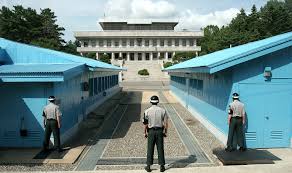
Towards a sensible approach to North Korean nuclear conflict
By Min Byung Chae
[divider]
[dropcap]T[/dropcap]here is no war scenario that ends in victory.”
So claims Han Kang, renowned South Korean author. In an opinion piece entitled “While U.S. Talks of War, South Korea Shudders” on The New York Times, Han asserts that South Koreans solely believe in a peaceful solution to the North Korean nuclear conflict. She berates US President Donald Trump for his nonchalant attitude towards a possible war in the Korean Peninsula and rebukes his promise of victory over North Korea as “an empty slogan, absurd and impossible.” Han attributes Trump’s remarks to how Americans have considered Koreans to be “subhuman,” and she equates them with US Army’s massacre of South Korean civilians during the Korean War, which she labels as a “proxy war.”
Han’s opinion peace caused a great sensation. Whereas writers on the right raised concerns about Han’s omission of North Korea’s nuclear provocations, Korean leftist newspapers praised her advocacy of peaceful solution. Even the Blue House, the South Korean presidential office, shared it on its Facebook page, in line with current South Korean president’s policy of rapprochement with North Korea.
This article, however, is troubling on numerous levels.
First and foremost, it is historically inaccurate. The Korean War was not merely a “proxy war enacted on the Korean Peninsula” by the US and USSR. It rather began with a calculated attack by Kim Il-Sung, founder of DPRK and the grandfather of Kim Jong-un, to unify Korea under North Korean rule. Emboldened by Communist victory over Nationalists in China in 1949, Kim decided to attack South Korea and begged Joseph Stalin to support the North Korean attack. But Stalin did not want the USSR to fight the US after its physical and human losses during the Second World War; he consented after Kim’s multiple pleas and the American troops’ withdrawal from South Korea. Meanwhile, the United States only came to South Korea’s rescue after the outbreak of war on June 25, 1950.
Han’s opinion piece is also misleading. She compares Trump’s remarks to No Gun Ri Massacre, in which American soldiers shot fleeing South Korean civilians for three days in July 1950, and blames it on Americans’ perception of South Korean refugees as “subhuman.” But the Americans were not the only ones dehumanized by war. North Korean soldiers killed unarmed South Korean doctors and patients at Seoul National University Hospital. Even the South Korean government massacred over 50,000 innocent civilians incorrectly labelled as communist sympathizers. War made everyone, not just Americans, violent.
Moreover, we must dissect Han’s claim that Americans have viewed Koreans to be “subhuman.” If this were true, why did the 37,000 American soldiers sacrifice their lives in Korea, while trying to protect a small country in the Far East they barely knew about? What about the American missionaries and their families who contributed to Korea’s modernization during the late 19th and early 20th centuries? Some of them, including their infants, died from disease and were buried in Korea. Did those Americans also consider Koreans to be “subhuman”?
Most importantly, Han’s emotional argument obscures Trump’s and Kim Jong-un’s underlying motivations in escalating the conflict. As Trump intensifies his verbal attack against “#NoKo” on Twitter, he is also using the conflict to stir up fear of war in South Korea and sway Korean public opinion closer to the US, so that he can elicit South Korean concessions on issues such as the growing US trade deficit with South Korea. Furthermore, Trump is using the North Korean nuclear threat to divert the domestic attention from his failure to implement his campaign promises, such as the abrogation of Affordable Care Act, and the Special Prosecutor’s investigation of Trump’s connection with Russia during the 2016 elections. In addition, Trump wishes to distinguish himself to the public on the North Korean issue with active policies, unlike the Obama administration that relied on “Strategic Patience” with North Korea.
Similarly, Kim Jong-un has developed the nuclear and missile programs for self-defense purposes. This can be seen in North Korean officials’ covert and continued attempts at negotiating with American diplomats and their insistence on being as a nuclear-weapon state. Kim Jong-un does not want to bomb Guam, Alaska, or Los Angeles. Rather, he wants DPRK to be on equal footing with US and eventually conclude a separate peace treaty with the US; in this way, Kim can force South Korea to capitulate to DPRK’s demands. Domestically, Kim Jong-un erases his father’s shrewd but opaque rule and pronounces his aggressive leadership to his people, through the development of nuclear weapons.
Now is not the time to monolithically interpret Donald Trump and Kim Jong-un as warmongers or “rocket man,” or rely on oversimplified versions of history to resolve the North Korean nuclear conflict. Rather, we should rationally evaluate the situation on a macro-level and carefully assess different actors’ incentives. Steadfast commitment may help us find the solution.
[hr]
Min Byung Chae ’20 is in Jonathan Edwards College. Contact him at minbyung.chae@yale.edu.